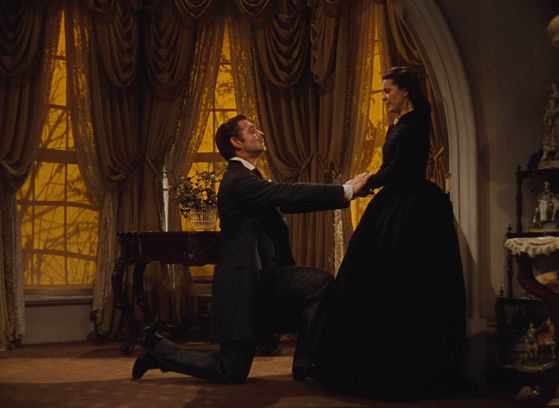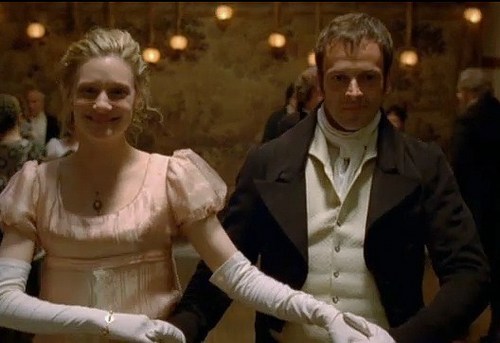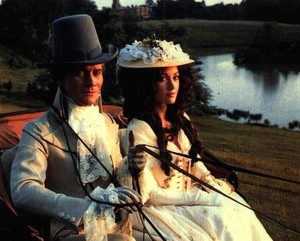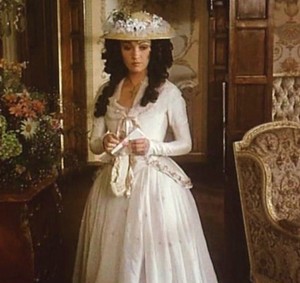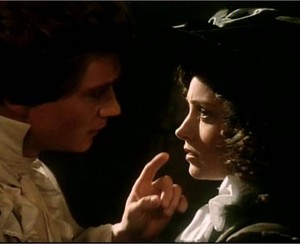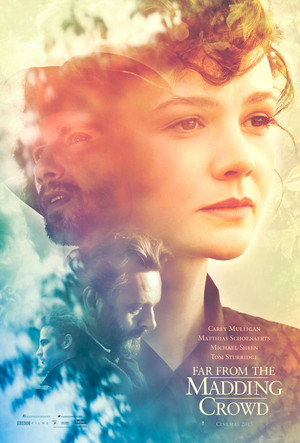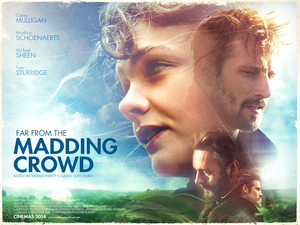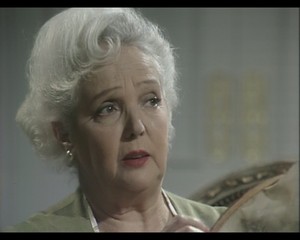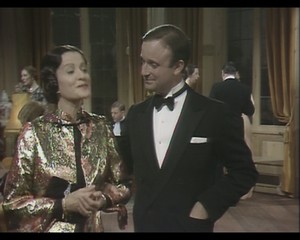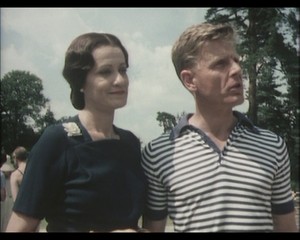"GONE WITH THE WIND" (1939) Review
Several years ago, I had come across an artigo that provided a list of old classics that the author felt might be overrated. One of those filmes turned out to be the 1939 Oscar winning film, "GONE WITH THE WIND". Not only did the author accuse the movie of being both racist and sexist, he also claimed that the movie had not aged very well over the past seven decades.
Did I agree with the author? Well, let me put it this way. I would say that "GONE WITH THE WIND" has managed to withstand the tests of time . . . to a certain extent. As the author had pointed out, the sexism and racism are obvious and rather off-putting. First of all, the slaves came across as too servile for my taste. Although there were moments when it seemed the slave Prissy did not particularly care for the movie's heroine, Scarlett O'Hara. And although Prissy was not the only dimwitted character in the story (think of Melanie and Charles Hamilton's Aunt Pittypatt, the Tarleton brothers, and yes, even Charles Hamilton himself), she had the bad luck to spout that unfortunate line that must have been the bane of actress borboleta McQueen’s life - "Miz Scarlett, I know nothin’ bout birthin’ no babies.". The movie's portrayal of the newly freed slaves struck me as schizophrenic. They either remained loyal to their former masters - like Mammy, Prissy and Pork (the O'Hara house servants); or they were shiftless, lazy blacks who easily "bought the Yankees' lies" and preyed upon their former masters and mistresses - especially white women. This last sentence reminded me of the Shantytown sequence. And I just remembered that both a white man and a black man nearly attacked Scarlett before she was rescued por Big Sam. In other words, this film was just as insulting to working-class whites (think former overseer Jonas Wilkerson and Emmy Slattery), as it was to the black characters. I forgot that despite its occasional celebration of the working-class (especially during the Depression Era), many Hollywood films tend to reek of class bigotry.
And the sexism was no better. I found the story's male romantic lead Rhett Butler’s determination to view Scarlett as his own personal child bride rather distasteful – along with his act of marital rape. The first half of the movie allowed Rhett to express some kind of respect toward Scarlett's pragmatism and ruthlessness. But once she became his wife, he seemed to long for some kind of child bride as well. But if I must be honest, I have seen filmes that are just as bad or even worse. I realize that the Melanie Hamilton character is highly regarded por many as the ideal woman, I personally found the character hard to accept. I nearly rolled my eyes in one scene that featured her sacrificing her wedding ring for "the Cause" (namely the Confederacy). That woman put the Madeline Fabray character from John Jakes' "North and South" trilogy to shame. Ideal characters - especially ideal women - have always been a turn off for me. They tend to beijoca, smack of illusions of the worst kind.
I had once seen "GONE WITH THE WIND" at one of my local movie theaters when it had been re-released to celebrate its 50th anniversary in 1989. The first half of the film struck me as being well-paced and filmed. The dialogue sparkled and Vivian Leigh and Clark Gable, and the rest of the cast could not have been better. I could not say the same for the film’s segundo half. The real problem with "GONE WITH THE WIND" manifested in Part Two. Once Scarlett had married Rhett . . . the movie slowly began to fizzle. Oh sure, it had its iconic moments – Scarlett appearing at Ashley’s birthday party in the infamous red dress, Bonnie Blue Butler’s death and Mammy's grief-stricken reaction. Unfortunately, it did not take me very long to fall asleep . . . even before poor Bonnie Blue’s death. I managed to wake up in time to witness Hattie McDaniel's brilliant monologue on the decline of Butlers' marriage and Bonnie Blue's death. I do not think one can really blame the movie's credited screenwriter, Sidney Howard and the screenwriters who worked on the project. Margaret Mitchell's novel had this same problem as the movie. Namely, it started brilliantly and ended with me crying in despair for the story to end. I suspect that Selznick had decided not to risk earning the fans' ire por refraining from changing the novel's structure too much after the other changes he had made.
And the main reason why "GONE WITH THE WIND" threatened to fizzle out in the end? Quite frankly, the story seemed unable to maintain the same pace throughout the film. Even worse, this seemed to have turned "GONE WITH THE WIND" into a movie with conflicting genres. I do not know whether to list it as a historical drama or a costumed melodrama. Most of the movie seemed like a historical drama – especially the first half that ends with Scarlett’s return to Tara. But once Scarlett’s segundo husband - Frank Kennedy – was killed during the Shantytown attack sequence, the movie purely became a costumed melodrama. This change in genre not only made the movie seemed slightly schizophrenic, it nearly grounded the film's pacing to a halt.
There were other minor aspects of "GONE WITH THE WIND" that I found rather questionable. Why was Melanie Wilkes living in Atlanta, following her marriage to Ashley Wilkes? Why did she not live with her in-laws at the Wilkes' plantation, Twelve Oaks? And why was Scarlett still living at Tara, following her marriage to Charles Hamilton? She should have moved into the início of his aunt, Pittypat Hamilton, in Atlanta. One featured a brief scene in which Eddie Anderson's Uncle Peter chasing a chicken in the Wilkes' backyard proclaiming it to be "the last chicken in Atlanta". Really? In December 1863, when the Union Army had yet to set foot in the state of Georgia, except at Fort Polaski, off the coast of Savannah? And could someone explain why social leaders like Mrs. Mayweather, Mrs. Meade and Aunt Pittypat needed Melanie's approval for an auction regarding the city's young female elite at the local charity bazaar and ball? Melanie was only a ano or two older than Scarlett and probably eighteen to nineteen years old at the time. I found the entire moment implausible. And who exactly created the infamous green dress that Scarlett wore to pay Rhett a visitor, when he was a prisoner of the Union Army? Scarlett? Her sisters? Mammy, who was a housekeeper and not a seamstress? Prissy? Why was Rhett a prisoner of the Union Army . . . after the war ended? And why did Big Sam have that ludicrous argument with the other O'Hara slave over who would order the other field slaves to stop working? He was the foreman. It was his job. The other man should have known that.
Speaking of Big Sam, he was also featured in a scene in which Scarlett spotted him and other former Tara field slaves marching through Atlanta and on their way to dig ditches for the Confederate Army defending the city. What made me shake my head in disbelief was not only Sam's cheerful attitude toward this task, but the fact that his fellow slaves were cantar "Go Down Moses", a song associated with American slaves' desire to flee bondage and the Underground Railroad. Either David O. Selznick or his production team had no knowledge of the historical significance of this song, or . . . this scene was some kind of ironic joke. Last, but not least, one scene in the movie's segundo half found Scarlett and Ashley arguing over their use of convicts as labor for her lumber mill. The problem is that the convicts were all white, and most convicts - then and now - were African-Americans. Is it possible that Selznick may have been guilty of whitewashing? Apparently so.
"GONE WITH THE WIND" does have its virtues. Most of the performances were first-rate. It especially benefited from Vivian Leigh as the movie's lead, Scarlett O'Hara; Clark Gable as the roguish Rhett Butler; Hattie McDaniel as Mammy; Olivia De Havilland as the sweetly Melanie Hamilton Wilkes; Thomas Mitchell as Gerald O'Hara; Barbara O'Neil as Ellen O'Neil; borboleta McQueen as Prissy Laura Hope Crews as Aunt Pittypat, and even Leslie Howard, who had the thankless job of portraying the aristocratic loser, Ashley Wilkes. In fact, one has to give Leigh credit for basically carrying a nearly four-hour movie on her own. But there were other performances that I found memorable - including Oscar Polk, Victor Jory, Harry Davenport, Evelyn Keyes, Ann Rutherford, Everett Brown, Carroll Nye and Rand Brooks. Leigh, Gable, De Havilland and McDaniels all received Academy Award nominations. Both Leigh and McDaniels won in their respective categories.
The movie also benefited from a strong first half, which covered the war years. From the movie's opening on Tara's porch to that last moment when a besieged Scarlett vowed to "never go hungry again" in the middle of one of Tara's fields, the movie steamed ahead with drive, without rushing along too face. In fact, I would say that the film's strongest sequence began with the Union Army's siege of Atlanta and ended with Scarlett, Melanie and Prissy's arrival at Tara. That sequence alone did an excellent job of expressing the horrors of war not only from the military point of view, but also from the viewpoints of civilians like Scarlett. Marceella Rabwin, producer David O. Selznick's former executive assistant, had credited Victor Fleming not only for his direction of this sequence, but also the film's strong drive and pacing. And since he ended up as the movie's main director, I guess I will also give him credit. It still amazes me that a Civil War movie with no battle scenes whatsoever, could have such a strong and well-paced narrative - at least in its first half.
The movie also benefited from the hiring of the Oscar winning production designer William Cameron Menzies, who used storyboards (a first in Hollywood for a live-action film) to provide the movie's look and style. He was able assisted por another Oscar winner, Lyle R. Wheeler, who created the movie's art designs. Many have complimented Walter Plunkett for his costume designs for the film. Granted, he had created some beautiful costumes. However, I do have a problem with some of Plunkett's designs. He had a bad habit of injecting modern fashion styles into some of his 19th century designs. Another virtue of the movie came from the score written and orchestrated por Max Steiner. Although he had received a nomination for his work, Steiner was defeated por Herbert Stothart's work for "THE WIZARD OF OZ". "GONE WITH THE WIND" also benefited from William Cameron Menzies' groundbreaking production designs for the film. Not only did his work help project the film's image of mid-19th century Georgia, but also introduced the use of storyboards for live-action films. These storyboards must have been a godsend not only for Lyle Wheeler's Oscar winning art direction, but also Ernest Haller and Lee Garmes' photography.
What else can I say about "GONE WITH THE WIND"? Unlike many other film critics and fans, it is not my favorito Best Picture winner. It is not even my favorito 1939 film. Between the overt political incorrectness and a weak segundo half, I would have never voted it as the 1939 Best Picture Oscar. But . . . despite its political incorrectness and the dull last hora of the film, "GONE WITH THE WIND" still managed to hold up pretty well after 75 to 76 years, thanks to its talented cast and crew and the drive of producer David O. Selznick.
Several years ago, I had come across an artigo that provided a list of old classics that the author felt might be overrated. One of those filmes turned out to be the 1939 Oscar winning film, "GONE WITH THE WIND". Not only did the author accuse the movie of being both racist and sexist, he also claimed that the movie had not aged very well over the past seven decades.
Did I agree with the author? Well, let me put it this way. I would say that "GONE WITH THE WIND" has managed to withstand the tests of time . . . to a certain extent. As the author had pointed out, the sexism and racism are obvious and rather off-putting. First of all, the slaves came across as too servile for my taste. Although there were moments when it seemed the slave Prissy did not particularly care for the movie's heroine, Scarlett O'Hara. And although Prissy was not the only dimwitted character in the story (think of Melanie and Charles Hamilton's Aunt Pittypatt, the Tarleton brothers, and yes, even Charles Hamilton himself), she had the bad luck to spout that unfortunate line that must have been the bane of actress borboleta McQueen’s life - "Miz Scarlett, I know nothin’ bout birthin’ no babies.". The movie's portrayal of the newly freed slaves struck me as schizophrenic. They either remained loyal to their former masters - like Mammy, Prissy and Pork (the O'Hara house servants); or they were shiftless, lazy blacks who easily "bought the Yankees' lies" and preyed upon their former masters and mistresses - especially white women. This last sentence reminded me of the Shantytown sequence. And I just remembered that both a white man and a black man nearly attacked Scarlett before she was rescued por Big Sam. In other words, this film was just as insulting to working-class whites (think former overseer Jonas Wilkerson and Emmy Slattery), as it was to the black characters. I forgot that despite its occasional celebration of the working-class (especially during the Depression Era), many Hollywood films tend to reek of class bigotry.
And the sexism was no better. I found the story's male romantic lead Rhett Butler’s determination to view Scarlett as his own personal child bride rather distasteful – along with his act of marital rape. The first half of the movie allowed Rhett to express some kind of respect toward Scarlett's pragmatism and ruthlessness. But once she became his wife, he seemed to long for some kind of child bride as well. But if I must be honest, I have seen filmes that are just as bad or even worse. I realize that the Melanie Hamilton character is highly regarded por many as the ideal woman, I personally found the character hard to accept. I nearly rolled my eyes in one scene that featured her sacrificing her wedding ring for "the Cause" (namely the Confederacy). That woman put the Madeline Fabray character from John Jakes' "North and South" trilogy to shame. Ideal characters - especially ideal women - have always been a turn off for me. They tend to beijoca, smack of illusions of the worst kind.
I had once seen "GONE WITH THE WIND" at one of my local movie theaters when it had been re-released to celebrate its 50th anniversary in 1989. The first half of the film struck me as being well-paced and filmed. The dialogue sparkled and Vivian Leigh and Clark Gable, and the rest of the cast could not have been better. I could not say the same for the film’s segundo half. The real problem with "GONE WITH THE WIND" manifested in Part Two. Once Scarlett had married Rhett . . . the movie slowly began to fizzle. Oh sure, it had its iconic moments – Scarlett appearing at Ashley’s birthday party in the infamous red dress, Bonnie Blue Butler’s death and Mammy's grief-stricken reaction. Unfortunately, it did not take me very long to fall asleep . . . even before poor Bonnie Blue’s death. I managed to wake up in time to witness Hattie McDaniel's brilliant monologue on the decline of Butlers' marriage and Bonnie Blue's death. I do not think one can really blame the movie's credited screenwriter, Sidney Howard and the screenwriters who worked on the project. Margaret Mitchell's novel had this same problem as the movie. Namely, it started brilliantly and ended with me crying in despair for the story to end. I suspect that Selznick had decided not to risk earning the fans' ire por refraining from changing the novel's structure too much after the other changes he had made.
And the main reason why "GONE WITH THE WIND" threatened to fizzle out in the end? Quite frankly, the story seemed unable to maintain the same pace throughout the film. Even worse, this seemed to have turned "GONE WITH THE WIND" into a movie with conflicting genres. I do not know whether to list it as a historical drama or a costumed melodrama. Most of the movie seemed like a historical drama – especially the first half that ends with Scarlett’s return to Tara. But once Scarlett’s segundo husband - Frank Kennedy – was killed during the Shantytown attack sequence, the movie purely became a costumed melodrama. This change in genre not only made the movie seemed slightly schizophrenic, it nearly grounded the film's pacing to a halt.
There were other minor aspects of "GONE WITH THE WIND" that I found rather questionable. Why was Melanie Wilkes living in Atlanta, following her marriage to Ashley Wilkes? Why did she not live with her in-laws at the Wilkes' plantation, Twelve Oaks? And why was Scarlett still living at Tara, following her marriage to Charles Hamilton? She should have moved into the início of his aunt, Pittypat Hamilton, in Atlanta. One featured a brief scene in which Eddie Anderson's Uncle Peter chasing a chicken in the Wilkes' backyard proclaiming it to be "the last chicken in Atlanta". Really? In December 1863, when the Union Army had yet to set foot in the state of Georgia, except at Fort Polaski, off the coast of Savannah? And could someone explain why social leaders like Mrs. Mayweather, Mrs. Meade and Aunt Pittypat needed Melanie's approval for an auction regarding the city's young female elite at the local charity bazaar and ball? Melanie was only a ano or two older than Scarlett and probably eighteen to nineteen years old at the time. I found the entire moment implausible. And who exactly created the infamous green dress that Scarlett wore to pay Rhett a visitor, when he was a prisoner of the Union Army? Scarlett? Her sisters? Mammy, who was a housekeeper and not a seamstress? Prissy? Why was Rhett a prisoner of the Union Army . . . after the war ended? And why did Big Sam have that ludicrous argument with the other O'Hara slave over who would order the other field slaves to stop working? He was the foreman. It was his job. The other man should have known that.
Speaking of Big Sam, he was also featured in a scene in which Scarlett spotted him and other former Tara field slaves marching through Atlanta and on their way to dig ditches for the Confederate Army defending the city. What made me shake my head in disbelief was not only Sam's cheerful attitude toward this task, but the fact that his fellow slaves were cantar "Go Down Moses", a song associated with American slaves' desire to flee bondage and the Underground Railroad. Either David O. Selznick or his production team had no knowledge of the historical significance of this song, or . . . this scene was some kind of ironic joke. Last, but not least, one scene in the movie's segundo half found Scarlett and Ashley arguing over their use of convicts as labor for her lumber mill. The problem is that the convicts were all white, and most convicts - then and now - were African-Americans. Is it possible that Selznick may have been guilty of whitewashing? Apparently so.
"GONE WITH THE WIND" does have its virtues. Most of the performances were first-rate. It especially benefited from Vivian Leigh as the movie's lead, Scarlett O'Hara; Clark Gable as the roguish Rhett Butler; Hattie McDaniel as Mammy; Olivia De Havilland as the sweetly Melanie Hamilton Wilkes; Thomas Mitchell as Gerald O'Hara; Barbara O'Neil as Ellen O'Neil; borboleta McQueen as Prissy Laura Hope Crews as Aunt Pittypat, and even Leslie Howard, who had the thankless job of portraying the aristocratic loser, Ashley Wilkes. In fact, one has to give Leigh credit for basically carrying a nearly four-hour movie on her own. But there were other performances that I found memorable - including Oscar Polk, Victor Jory, Harry Davenport, Evelyn Keyes, Ann Rutherford, Everett Brown, Carroll Nye and Rand Brooks. Leigh, Gable, De Havilland and McDaniels all received Academy Award nominations. Both Leigh and McDaniels won in their respective categories.
The movie also benefited from a strong first half, which covered the war years. From the movie's opening on Tara's porch to that last moment when a besieged Scarlett vowed to "never go hungry again" in the middle of one of Tara's fields, the movie steamed ahead with drive, without rushing along too face. In fact, I would say that the film's strongest sequence began with the Union Army's siege of Atlanta and ended with Scarlett, Melanie and Prissy's arrival at Tara. That sequence alone did an excellent job of expressing the horrors of war not only from the military point of view, but also from the viewpoints of civilians like Scarlett. Marceella Rabwin, producer David O. Selznick's former executive assistant, had credited Victor Fleming not only for his direction of this sequence, but also the film's strong drive and pacing. And since he ended up as the movie's main director, I guess I will also give him credit. It still amazes me that a Civil War movie with no battle scenes whatsoever, could have such a strong and well-paced narrative - at least in its first half.
The movie also benefited from the hiring of the Oscar winning production designer William Cameron Menzies, who used storyboards (a first in Hollywood for a live-action film) to provide the movie's look and style. He was able assisted por another Oscar winner, Lyle R. Wheeler, who created the movie's art designs. Many have complimented Walter Plunkett for his costume designs for the film. Granted, he had created some beautiful costumes. However, I do have a problem with some of Plunkett's designs. He had a bad habit of injecting modern fashion styles into some of his 19th century designs. Another virtue of the movie came from the score written and orchestrated por Max Steiner. Although he had received a nomination for his work, Steiner was defeated por Herbert Stothart's work for "THE WIZARD OF OZ". "GONE WITH THE WIND" also benefited from William Cameron Menzies' groundbreaking production designs for the film. Not only did his work help project the film's image of mid-19th century Georgia, but also introduced the use of storyboards for live-action films. These storyboards must have been a godsend not only for Lyle Wheeler's Oscar winning art direction, but also Ernest Haller and Lee Garmes' photography.
What else can I say about "GONE WITH THE WIND"? Unlike many other film critics and fans, it is not my favorito Best Picture winner. It is not even my favorito 1939 film. Between the overt political incorrectness and a weak segundo half, I would have never voted it as the 1939 Best Picture Oscar. But . . . despite its political incorrectness and the dull last hora of the film, "GONE WITH THE WIND" still managed to hold up pretty well after 75 to 76 years, thanks to its talented cast and crew and the drive of producer David O. Selznick.



